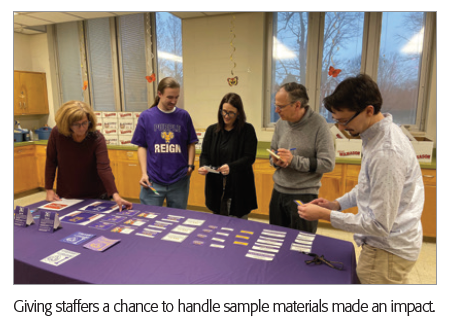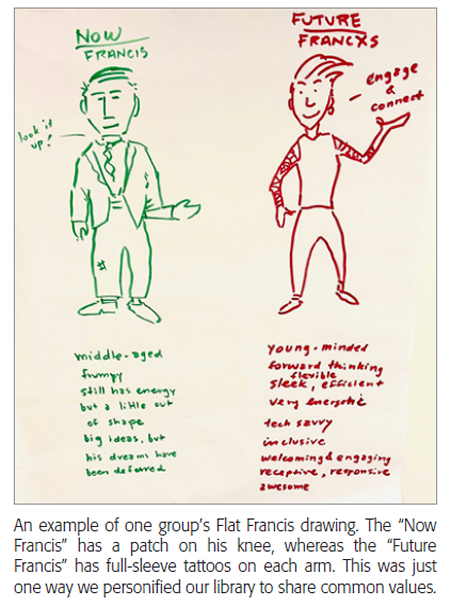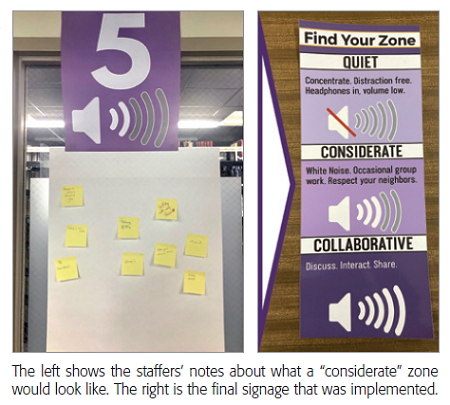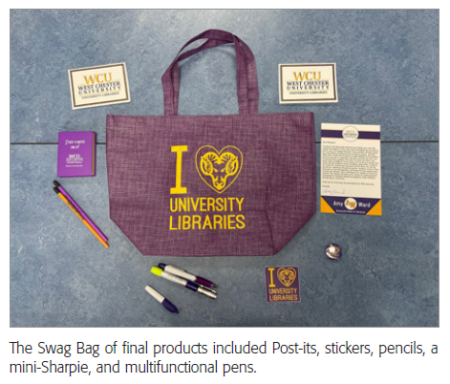 We work in a midsized academic library for a state university in West Chester, Pa., a suburb of Philadelphia. Our library’s leadership changed in 2017, and we took this opportunity to embark on a rebranding effort. One of the challenges we faced was bringing librarians and library technicians (non-M.L.S., non-faculty employees) together to buy into a common visual identity. We work in a midsized academic library for a state university in West Chester, Pa., a suburb of Philadelphia. Our library’s leadership changed in 2017, and we took this opportunity to embark on a rebranding effort. One of the challenges we faced was bringing librarians and library technicians (non-M.L.S., non-faculty employees) together to buy into a common visual identity.
From previous initiatives, members of our marketing team (including both of us and four others) had learned that if we brought a finished marketing or promotional product to our library colleagues, their feedback was only marginally positive. Not very many of our colleagues walked away feeling empowered to take ownership of the marketing we had planned. As we evaluated our past failures and successes, we came to the realization that even if we presented a brilliant and cohesive campaign, it would not succeed without support and buy-in from our library colleagues. So we needed to focus on an internal marketing plan that aligned with all stages of the Cycle of True Marketing (www.LibrariesAreEssential.com/library-marketing-resources/cycle-of-true-marketing), which we’ve adopted.
There is a wealth of information explaining how to develop marketing strategies for libraries, but we found very little information to help us develop concrete internal marketing strategies. So, we created our own internal marketing planning process, modeled after segments from the marketing cycle.
The reasoning behind this decision was twofold: 1) to ensure our internal marketing goals could scale up or down depending on the size of the specific marketing initiative and 2) to be able to insert the internal marketing plan at any point of the marketing cycle. Our process includes choosing a target audience, listing outcomes for it, and filling in details on how to reach each outcome. Those details cover communication channels, activities for staffers to participate in, calls to action, and ways for staffers to provide feedback.
It is important to note that you should list more than one outcome. For practicality’s sake, having more than one helps to break down the internal marketing goal into achievable steps; for creativity’s sake, crafting a variety of activities for the library staff can result in increased engagement.
The marketing initiative we discuss in this article was a rebranding effort for our library organization. The scale was quite large, so we needed an internal marketing plan to match.
We decided on the goal of developing programming to increase inter-departmental communication, to promote shared values and purpose, and to empower colleagues to exemplify our library’s mission in their day-to-day tasks. We had to include everyone—librarians, library technicians, and student workers—a total of 75 people. However, we knew we needed to tailor messaging for each of those segments.
Our internal marketing goal determined our three outcomes:
1. If we aimed to increase communication, we needed to establish, or re-establish, expectations.
2. If we aimed to promote shared values and purpose, we needed to confirm, or reconfirm, common values.
3. And, if we aimed for our colleagues to feel empowered, we needed to include them from the beginning and show that we considered their contributions and applied them in our final products.
To accomplish each outcome, we facilitated three events; each event addressed one of the outcomes from our internal marketing plan and involved all library personnel.
Internal Marketing Initiatives
Event #1. The first event aimed to set expectations between us, the library’s marketing team, and our library colleagues. The purpose was to ensure everyone was committing to open and shared dialogue. We sent out a link to a survey that co-workers could submit anonymously. We asked two questions: What do we do well as a library and What are our next opportunities? (These should be familiar; it’s a truncated version of a SWOT analysis. We purposely avoided weaknesses and threats from this exercise to keep everyone’s focus positive.)
We compiled the responses, then sent them to each department and asked their members to meet as a group to pick their top three responses for both questions. In addition, we asked each department to answer two more questions as a group:
1. In what ways can the library’s marketing team work with you?
2. In what ways can you work with the library’s marketing team?
 At the end of this exercise, two expectations emerged from the dialogue: Library personnel have expertise to contribute to marketing and/or promotional initiatives, and everyone has a role to play in library marketing, no matter how big or small. At the end of this exercise, two expectations emerged from the dialogue: Library personnel have expertise to contribute to marketing and/or promotional initiatives, and everyone has a role to play in library marketing, no matter how big or small.
Event #2. Following up on the success of this event, we asked the dean of the library for time during an all-staff meeting for a second event. The Flat Francis exercise, focusing on confirming common values, was suited for the type of gathering where librarians and library technicians comingle more casually. There were four self-identified groups, and we gave each a presentation-sized Post-it paper and colored markers. We asked each group to personify our library by drawing a person. Since our library was named after a former English professor, Francis Harvey Green, we called the persona “Francis.”
We asked our colleagues to think about what clothes this person would wear today, what he or she would carry with them, and what he or she would request from their library. In addition, we asked for a list of the other qualities and values that describe our library today.
After that, we asked each group to draw the Francis of the future and list the qualities they would want to see. This was designed to be fun, creative, and jocular. At the end, each group shared their present and future Francis drawings.
The Flat Francis event helped us (re)discover the shared values we needed to bring into our rebranding campaign. The marketing team held meetings to reflect on these values and to plan how to incorporate them into our visual identity. We spent 6 months after these meetings drafting and revising different elements for our visual identity. Once we had established the main elements of our new brand, we created a unique way for our colleagues to provide feedback.
Event #3. We developed our third event, a graphic design showcase, with the motto “If you build it, they will come.” Using the visuals we’d settled on, we built prototypes (at scale) of the branded promotional items we wanted to produce. We debuted them at our showcase so colleagues could handle and inspect them.
The prototypes included various signage, library cards, branded notecards, swag to give away, and tote bag designs. (We handmade them all with items in our own library.) All featured new racing-stripe design options, which represented the dynamic guidance our colleagues provide to our community. We delivered a tactile experience and asked our colleagues to provide honest and actionable feedback and suggest ways they could contribute their skills to future projects.
The feedback from the graphic design showcase directly impacted the design and development process of our visual identity. Our colleagues said the racing-stripe design option and color scheme were appealing and provided a unifying visual identity. They suggested we discard one series of notecards because the design clashed with the racing-stripe design.
 |
 |
We made many adjustments to the designs after the showcase, but budget restrictions prevented the production of all of the prototypes. To help us narrow down the options, we assembled a focus group that included a mix of librarians and technicians who had indicated they wanted to continue to be a part of the conversation. We encouraged debate about which showcase items to produce. In addition, staffers suggested other items that we had not presented at the showcase. For example, one of our technicians encouraged us to create laptop stickers and window decals with the design we had on the tote bag. We did produce the laptop stickers, and they have become our most successful piece of library swag.
Giving our colleagues the opportunity to have a direct impact in creating the future of our library was a powerful experience. We saw a sense of ownership and empowerment develop during these conversations, and the shared experiences unified our staff members.
Thanks and Continued Cooperation
To thank everyone and to celebrate our new shared visual identity, we hand-delivered to each employee a package of final products, all of which were shaped by the feedback they had given us. The items included a tote bag, a laptop sticker, a “Stick A Note On It” Post-it notebook, notecards, and other fun items to round out the experience. We included a letter in the package that expressed our appreciation for the input we received. It also said that our colleagues would have more opportunities to share their feedback in a way that would continue to grow our brand.
After we had introduced this visual identity, our colleagues came to us with ideas for new projects. Our student success librarian created a passport book highlighting library service points, designed as an activity for first-year students. Our electronic resources librarian created a brochure for new faculty to promote open educational resources. Subsequently, our humanities librarian adapted this design to advertise our online chat service. When our colleagues felt empowered to bring promotional requests to us, the design templates we created were widely accepted.
Finally, we asked our colleagues to contribute language to describe the new noise zones we were establishing for our various study spaces. After we completed the design of the new noise zone signage using the language from our colleagues (see above), we asked for a vote on a name to set the tone for our colleagues that we welcomed ideas even outside of the events we organized.
Best Practices and Lessons Learned
We developed and implemented our internal marketing plan over the course of 18 months and identified best practices we continue to employ today. Here’s our best advice for others:
1. Create immersive experiences for your colleagues that are different from their traditional workdays. You can accomplish this by hosting events with high-participation activities.
2. Give your colleagues several different opportunities to provide feedback and to engage in creative problem-solving. This uncovers hidden talents in others and empowers staff members to contribute to the larger mission of the library.
3. Build prototypes as close to the finished products as possible to hold and explore. This will increase engagement and help generate feedback you can use to achieve internal marketing goals. This process let us present a cohesive system of ideas under one visual identity, while maintaining the ability to modify that system from feedback.
Finally, we learned a lot of lessons from this journey. Our colleagues needed to know that we believed in their abilities, that their work has value, and that they can make new contributions in their roles. We learned to celebrate and express appreciation to our co-workers when they contributed their perspectives and opinions. We followed up with them to show them how those helped improve our final products.
We learned to recognize where to devote our energy. Not all of our colleagues wanted to participate in this process. We gave ourselves the permission to let them be and focused our energies on those who were interested. Still, we left room for our colleagues to surprise us. Sometimes, the people we least expected to participate were the ones who delivered the most insightful feedback.
Ultimately, internal marketing has become a continuous process about authentically discovering the talents of the people we work with and empowering them to use those skills to constantly transform their library.
|